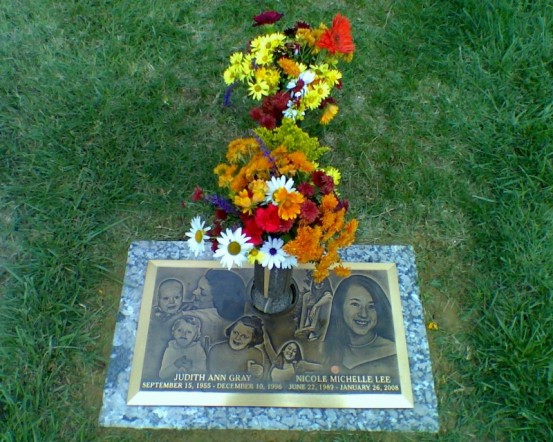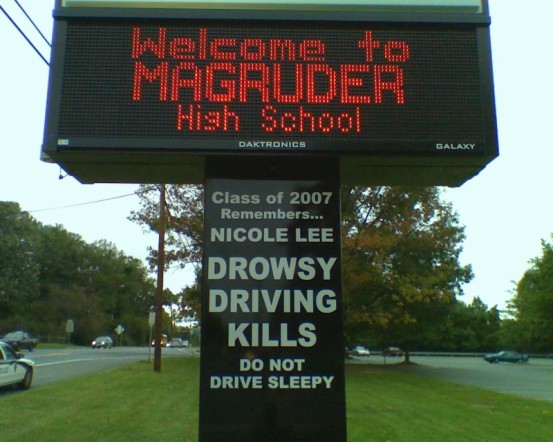Drowsy Driving Kills
In Loving Memory of Nicole
Nicole was a very special person.
A selfless individual who touched many people in many ways.
Did You Know?
100,00 motor vehicle accidents each year are by fatigued drivers.
55% of drowsy driving crashes are caused by drivers less than 25 years old.
Being awake for 18 hours is equal to a blood alcohol concentration (BAC) of 0.08% which is legally drunk and leaves you at risk for a crash.
How can you tell if you are “driving while drowsy”?
Your eyelids droop and your head starts to nod. Yawning becomes almost constant and your vision seems blurry. You blink hard, focus your eyes and suddenly realize that you’ve veered onto the shoulder or into oncoming traffic for a moment and quickly straighten the wheel. This time you were lucky; next time you could become the latest victim of the tragedy of drowsy driving.
According to the National Sleep Foundation’s Sleep in America poll, 60% of Americans have driven while feeling sleepy and 37% admit to actually having fallen asleep at the wheel in the past year. However, many people cannot tell if or when they are about to fall asleep. And if sleepiness comes on while driving, many say to themselves, “I can handle this, I’ll be fine.” Yet they’re putting themselves and others in danger. What they really need is a nap or a good night’s sleep.
Here are some signs that should tell a driver to stop and rest:
- Difficulty focusing, frequent blinking, or heavy eyelids
- Daydreaming; wandering/disconnected thoughts
- Trouble remembering the last few miles driven; missing exits or traffic signs
- Yawning repeatedly or rubbing your eyes
- Trouble keeping your head up
- Drifting from your lane, tailgating, or hitting a shoulder rumble strip
- Feeling restless and irritable
Are You at Risk?
Before you drive, consider whether you are:
- Sleep-deprived or fatigued (6 hours of sleep or less triples your risk)
- Suffering from sleep loss (insomnia), poor quality sleep, or a sleep debt
- Driving long distances without proper rest breaks
- Driving through the night, mid-afternoon or when you would normally be asleep
- Taking sedating medications (antidepressants, cold tablets, antihistamines)
- Working more than 60 hours a week (increases your risk by 40%)
- Working more than one job and your main job involves shift work
- Drinking even small amounts of alcohol
- Driving alone or on a long, rural, dark or boring road
Facts and Stats
According to the National Sleep Foundation’s 2005 Sleep in America poll, 60% of adult drivers – about 168 million people – say they have driven a vehicle while feeling drowsy in the past year, and more than one-third, (37% or 103 million people), have actually fallen asleep at the wheel! In fact, of those who have nodded off, 13% say they have done so at least once a month. Four percent – approximately eleven million drivers – admit they have had an accident or near accident because they dozed off or were too tired to drive.
The National Highway Traffic Safety Administration conservatively estimates that 100,000 police-reported crashes are the direct result of driver fatigue each year. This results in an estimated 1,550 deaths, 71,000 injuries, and $12.5 billion in monetary losses. These figures may be the tip of the iceberg, since currently it is difficult to attribute crashes to sleepiness.
- There is no test to determine sleepiness as there is for intoxication, i.e. a “Breathalyzer”.
- State reporting practices are inconsistent. There is little or no police training in identifying drowsiness as a crash factor. Every state currently addresses fatigue and/or sleepiness in some way in their crash report forms. However, the codes are inconsistent and two states (Missouri and Wisconsin) do not have specific codes for fatigue and/or fell asleep.
- Self-reporting is unreliable.
- Drowsiness/fatigue may play a role in crashes attributed to other causes such as alcohol. About one million such crashes annually are thought to be produced by driver inattention/lapses.
- According to data from Australia, England, Finland, and other European nations, all of whom have more consistent crash reporting procedures than the U.S., drowsy driving represents 10 to 30 percent of all crashes.
Countermeasures
Before “hitting the road”
- Get adequate sleep—most adults need 7-9 hours to maintain proper alertness during the day
- Schedule proper breaks—about every 100 miles or 2 hours during long trips
- Arrange for a travel companion—someone to talk with and share the driving
- Avoid alcohol and sedating medications—check your labels or ask your doctor
Countermeasures to Prevent a Fall-Asleep Crash While Driving
- Watch for the warning signs of fatigue—see above
- Stop driving—pull off at the next exit, rest area or find a place to sleep for the night
- Take a nap—find a safe place to take a 15 to 20-minute nap
- Consume caffeine—the equivalent of 2 cups of coffee can increase alertness for several hours
- Try consuming caffeine before taking a short nap to get the benefits of both
Caffeine — does it help?
Caffeine promotes short-term alertness. It takes about 30 minutes for caffeine to begin working so the best thing to do is pull over for a coffee or other caffeinated beverage, take a short nap, and then get back on the road. Keep in mind that caffeine won’t have much of an effect on people who consume it regularly.


